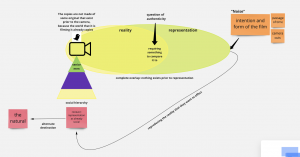Hi all, in this week’s blog post I wanted to experiment with the “add media” function to insert a map of how I am starting to deconstruct our conversation yesterday in reference to Shannon’s model of communication.
I first started this map with our thoughts on authenticity; I felt that Rei’s comment on how authenticity can only be considered when there is something to compare it with (ex. prior to Western colonialism) was extremely important to visualize. I put this question at the center of overlapping circles because we discussed for the Kayapo, that it is necessary for representation to produce the social. The camera is also included in these circles, as the video is extending and participating in the ceremony and therefore the creation of social value.
I put the Kayapo social hierarchy (please excuse my typo on hierarchy on the image) underneath the camera because the concentration of social power is the highest at the center of the village (with the senior men); this shows how the camera becomes a potent form of reproducing Kayapo society. In this way, the whole production of society runs through the camera.
I also wanted to include the aspect of “noise” that Shannon’s model includes; I was thinking about how we discussed with film cuts that the camera-person changes positions but an inconclusive amount of time has passed. I additionally thought it was super interesting how Professor Himpele pointed out that the sound volume was the same in the film when the camera was in the center of the circle and in an aerial shot; I never noticed that beforehand. I feel like noise in this sense alters the intention and form of the film; would it then also affect the social value of the representation of the ceremony? I feel like because this model of communication has circular elements, rather than a linear model, I am continuing to find overlapping features and connecting elements.
I am excited to continue this conversation in class on Tuesday as we take apart media to analyze its’ construction.

Lauren – thanks for taking the time to chart these relationships! It does a great job of making the complexity intelligible. I like how the social system is the basis for the camera – it illustrates the idea that only society comes prior to representation, but representations are ingredient of social production. The question of noise, therefore, is interesting. In Shannon’s usage, it refers to external distortions of an original message. But do the edits (exclusions) in the film alter the original message, or do they help construct and sharpen it? It’s also worth remembering that we are watching the Granada TV film, and not a Kayapo film. These two seem to be blended in the chart above. Nevertheless, Kayapo videographers do edit their work too. Based on what you know about the social life of representation, what would the Kayapo say about Shannons’ idea of “noise”? What a great discussion question you’ve raised!